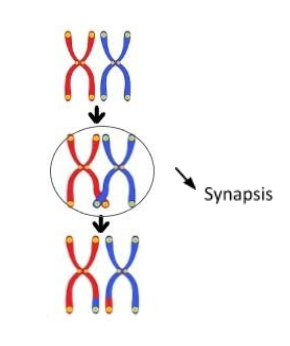
Synapsis occurs between-
a. mRNA and ribosome
b. Spindle fibres and centromere
c. Two homologous chromosomes
d. A male and female gamete.
Answer
486.6k+ views
Hint: The synapsis is a process that occurs between chromosomes just before the process of crossing over. This process helps in the pairing of chromosomes before the segregation process.
Complete answer:
The synapsis is the process by which pairing of homologous chromosomes occurs by crossing over. This crossing over generally takes place at its zygotene stage of meiosis. During the process of meiosis, the pairing of the homologous chromosomes occurs. After this the pairing is separated in order to reduce the genetic content of the gamete. The exchange of chromosomal segments occurs after the synapsis and this causes a genetic recombination among them. The genetic recombination further causes variation in the gene pool of a population. Hence the option (c) two homologous chromosomes is the correct option.

In the beginning of the translation process, the ribosome and a tRNA remain attached to the mRNA. The tRNA at that time is generally located at the ribosome's first docking site. The tRNA carries the amino acid that corresponds to that codon. Hence, in between the mRNA and ribosome, synapsis does not occur or has no function. So, the option (a) mRNA and ribosome is incorrect.
The centromere is the specialized DNA sequence. They are the part of a chromosome that links a pair of sister chromatids. During the process of mitosis, the spindle fibers attach to the centromere via the kinetochore. Here, no synapsis is formed. So the option (b) spindle fibres and centromere is the incorrect option.
Gametes are defined as an organism's reproductive cells or sex cells. Female gametes are called ova or egg cells and male gametes are called sperm. Gametes are normally haploid cells. Each of these cells carries only one copy of each chromosome. There is no such link called synapsis that is formed between the male and female gamete. So, the option (d) male and female gamete is incorrect.
Hence, The correct answer is option (C).
Additional information:
The difference between synapsis and crossing over is that, the synapsis is pairing of homologous chromosomes before the process of crossing over. On the other hand, the crossing over is the process of exchange of genetic material during synapsis.
Note: The process of synopsis starts when the protein that connects the various chromosomes to the nuclear membranes begins migrating. The protein component keeps on migrating in order to find its counterpart to bind. These counterparts and protein complexes help to hold the homologous chromosomes together. The complex formed is known as synaptonemal complex.
Complete answer:
The synapsis is the process by which pairing of homologous chromosomes occurs by crossing over. This crossing over generally takes place at its zygotene stage of meiosis. During the process of meiosis, the pairing of the homologous chromosomes occurs. After this the pairing is separated in order to reduce the genetic content of the gamete. The exchange of chromosomal segments occurs after the synapsis and this causes a genetic recombination among them. The genetic recombination further causes variation in the gene pool of a population. Hence the option (c) two homologous chromosomes is the correct option.

In the beginning of the translation process, the ribosome and a tRNA remain attached to the mRNA. The tRNA at that time is generally located at the ribosome's first docking site. The tRNA carries the amino acid that corresponds to that codon. Hence, in between the mRNA and ribosome, synapsis does not occur or has no function. So, the option (a) mRNA and ribosome is incorrect.
The centromere is the specialized DNA sequence. They are the part of a chromosome that links a pair of sister chromatids. During the process of mitosis, the spindle fibers attach to the centromere via the kinetochore. Here, no synapsis is formed. So the option (b) spindle fibres and centromere is the incorrect option.
Gametes are defined as an organism's reproductive cells or sex cells. Female gametes are called ova or egg cells and male gametes are called sperm. Gametes are normally haploid cells. Each of these cells carries only one copy of each chromosome. There is no such link called synapsis that is formed between the male and female gamete. So, the option (d) male and female gamete is incorrect.
Hence, The correct answer is option (C).
Additional information:
The difference between synapsis and crossing over is that, the synapsis is pairing of homologous chromosomes before the process of crossing over. On the other hand, the crossing over is the process of exchange of genetic material during synapsis.
Note: The process of synopsis starts when the protein that connects the various chromosomes to the nuclear membranes begins migrating. The protein component keeps on migrating in order to find its counterpart to bind. These counterparts and protein complexes help to hold the homologous chromosomes together. The complex formed is known as synaptonemal complex.
Recently Updated Pages
Master Class 12 Economics: Engaging Questions & Answers for Success

Master Class 12 Maths: Engaging Questions & Answers for Success

Master Class 12 Biology: Engaging Questions & Answers for Success

Master Class 12 Physics: Engaging Questions & Answers for Success

Master Class 11 Accountancy: Engaging Questions & Answers for Success

Glucose when reduced with HI and red Phosphorus gives class 11 chemistry CBSE

Trending doubts
10 examples of friction in our daily life

One Metric ton is equal to kg A 10000 B 1000 C 100 class 11 physics CBSE

Difference Between Prokaryotic Cells and Eukaryotic Cells

State and prove Bernoullis theorem class 11 physics CBSE

What organs are located on the left side of your body class 11 biology CBSE

How many valence electrons does nitrogen have class 11 chemistry CBSE




